---
description: Troubleshooting, logs, and known issues
keywords: mac, troubleshooting, logs, issues
redirect_from:
- /mackit/troubleshoot/
title: Logs and troubleshooting
---
Here is information about how to diagnose and troubleshoot problems, send logs
and communicate with the Docker for Mac team, use our forums and Knowledge Hub,
browse and log issues on GitHub, and find workarounds for known problems.
## Docker Knowledge Hub
**Looking for help with Docker for Mac?** Check out the [Docker Knowledge
Hub](http://success.docker.com/) for knowledge base articles, FAQs, and
technical support for various subscription levels.
## Diagnose problems, send feedback, and create GitHub issues
If you encounter problems for which you do not find solutions in this
documentation, on [Docker for Mac issues on
GitHub](https://github.com/docker/for-mac/issues), or the [Docker for Mac
forum](https://forums.docker.com/c/docker-for-mac), we can help you troubleshoot
the log data.
Choose {: .inline} -->
**Diagnose & Feedback** from the menu bar.
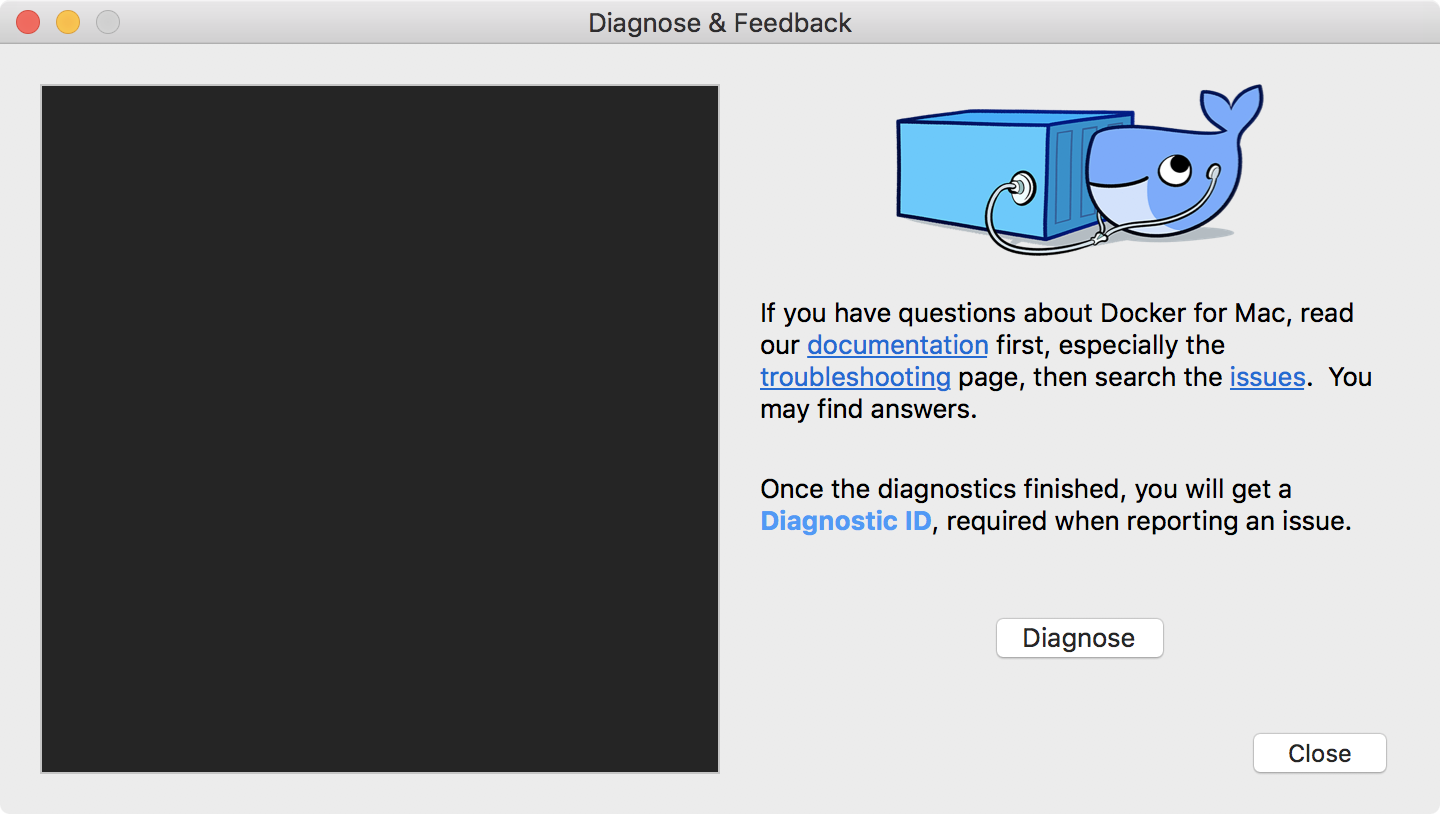
Select **Diagnose**. It runs diagnostics, shows results, and uploads the
results to Docker. A diagnostic ID is generated, which must be provided when
communicating with the Docker Team. Optionally, you can open an issue on GitHub
using the uploaded results and ID as a basis.
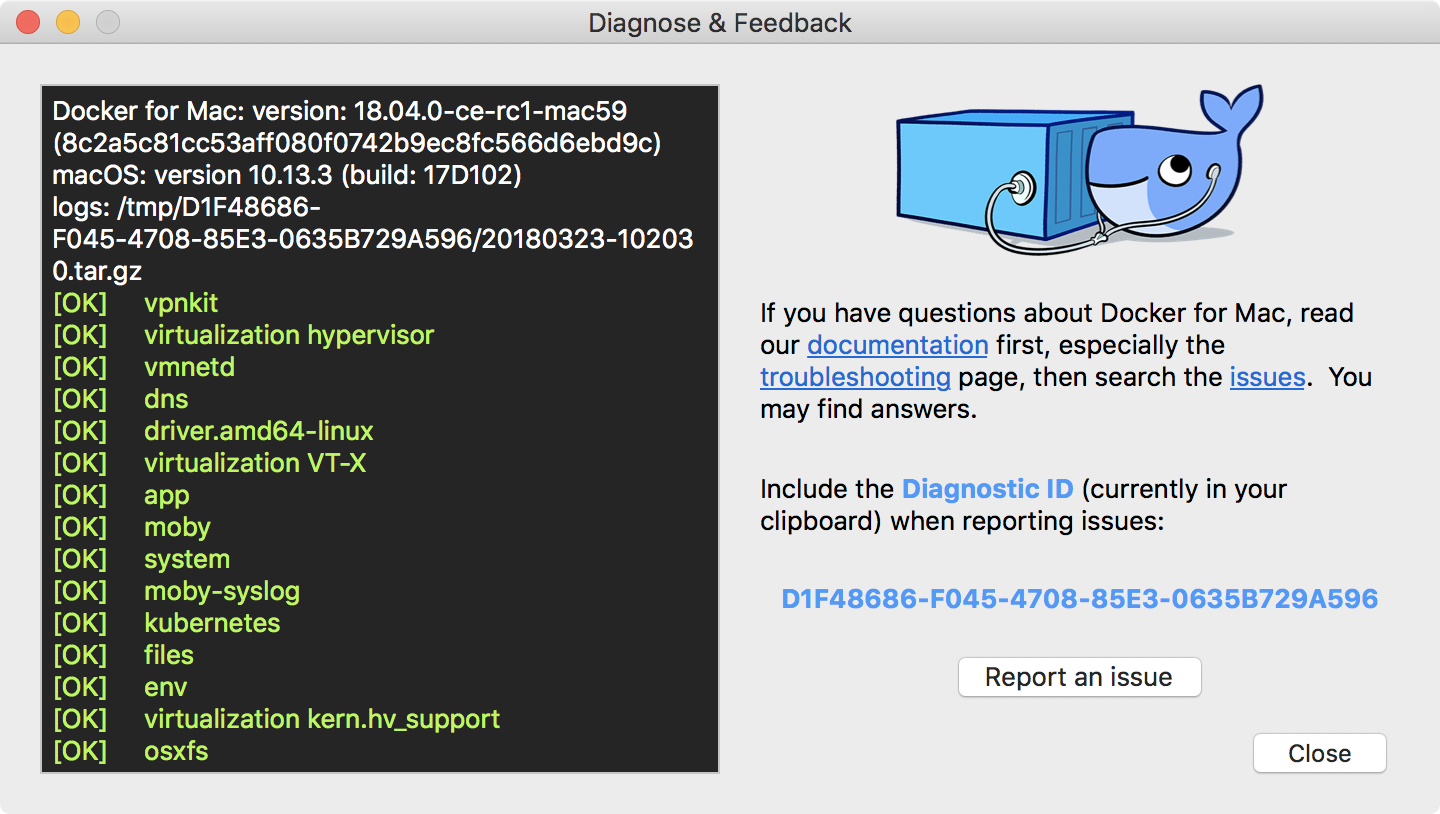
If you click **Report an issue**, this opens [Docker for Mac issues on
GitHub](https://github.com/docker/for-mac/issues/) in your web browser in a
“create new issue” template, to be completed before submission.
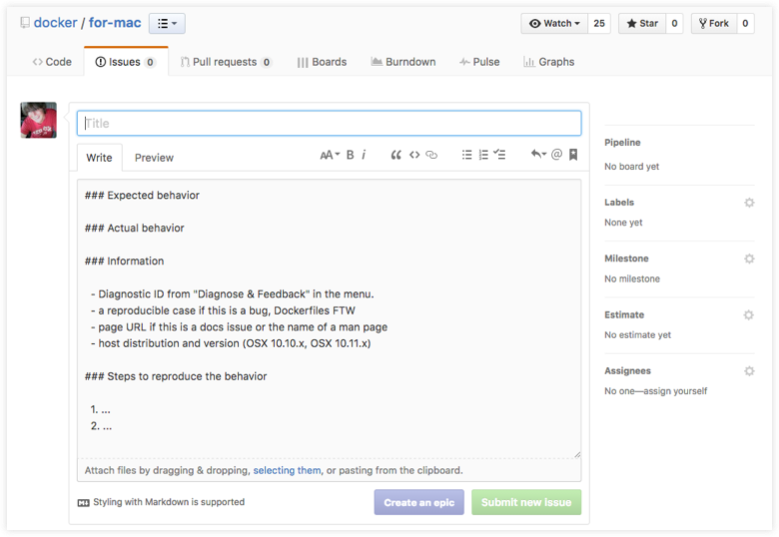
## Check the logs
In addition to using the diagnose and feedback option to submit logs, you can
browse the logs yourself.
#### Use the command line to view logs
To view Docker for Mac logs at the command line, type this command in a terminal
window or your favorite shell.
$ syslog -k Sender Docker
Alternatively, you can send the output of this command to a file. The following
command redirects the log output to a file called `my_docker_logs.txt`.
$ syslog -k Sender Docker > ~/Desktop/my_docker_logs.txt
#### Use the Mac Console for log queries
Macs provide a built-in log viewer. You can use the Mac Console System Log Query
to check Docker app logs.
The Console lives on your Mac hard drive in `Applications` > `Utilities`. You
can bring it up quickly by just searching for it with Spotlight Search.
To find all Docker app log messages, do the following.
1. From the Console menu, choose **File** > **New System Log Query...**
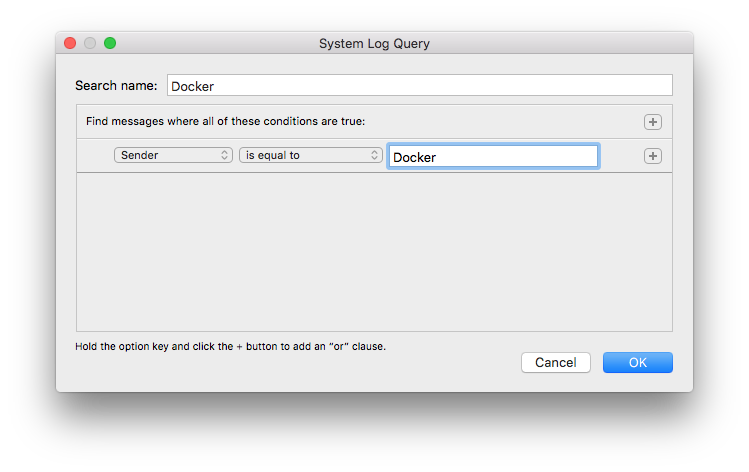
* Name your search (for example `Docker`)
* Set the **Sender** to **Docker**
2. Click **OK** to run the log query.
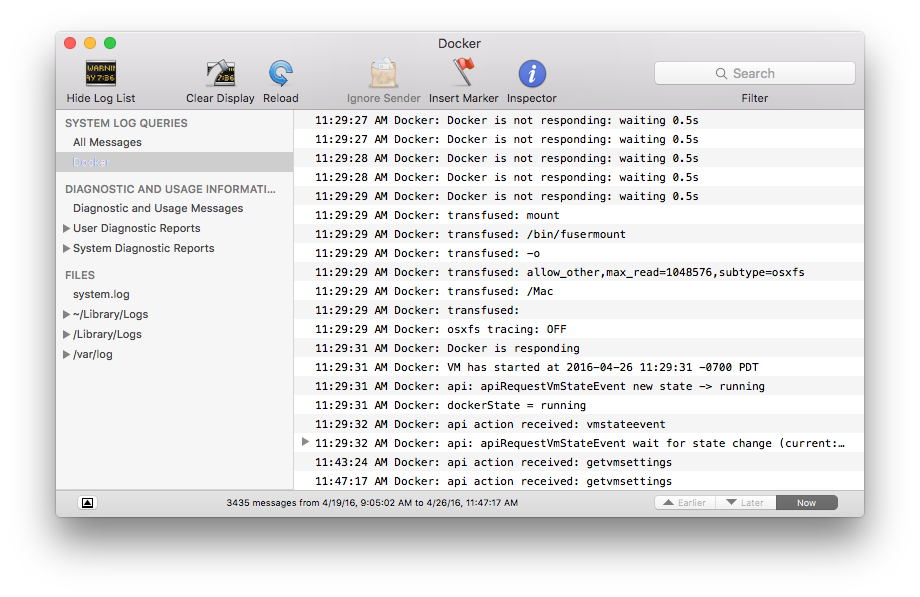
You can use the Console Log Query to search logs, filter the results in various
ways, and create reports.
For example, you could construct a search for log messages sent by Docker that
contain the word `hypervisor` then filter the results by time (earlier, later,
now).
The diagnostics and usage information to the left of the results provide
auto-generated reports on packages.
## Troubleshooting
### Make sure certificates are set up correctly
Docker for Mac ignores certificates listed under insecure registries, and
does not send client certificates to them. Commands like `docker run` that
attempt to pull from the registry produces error messages on the command
line, like this:
```
Error response from daemon: Get http://192.168.203.139:5858/v2/: malformed HTTP response "\x15\x03\x01\x00\x02\x02"
```
As well as on the registry. For example:
```
2017/06/20 18:15:30 http: TLS handshake error from 192.168.203.139:52882: tls: client didn't provide a certificate
2017/06/20 18:15:30 http: TLS handshake error from 192.168.203.139:52883: tls: first record does not look like a TLS handshake
```
For more about using client and server side certificates, see [Adding
TLS certificates](index.md#adding-tls-certificates) in
the Getting Started topic.
### Docker for Mac does not start if Mac user account and home folder are renamed after installing the app
If, after installing Docker for Mac, you [change the name of your macOS user
account and home folder](https://support.apple.com/en-us/HT201548), Docker for
Mac fails to start. To solve this problem, uninstall and reinstall Docker for Mac under the new user account.
See also, the discussion on the issue
[docker/for-mac#1209](https://github.com/docker/for-mac/issues/1209) and [Do I
need to reinstall Docker for Mac if I change the name of my macOS
account?](faqs.md#do-i-need-to-reinstall-docker-for-mac-if-i-change-the-name-of-my-macos-account)
in the FAQs.
### Volume mounting requires file sharing for any project directories outside of `/Users`
If you are using mounted volumes and get runtime errors indicating an
application file is not found, access to a volume mount is denied, or a service cannot
start, such as when using [Docker Compose](/compose/gettingstarted.md), you might
need to enable [file sharing](index.md#file-sharing).
Volume mounting requires shared drives for projects that live outside of the
`/Users` directory. Go to {:
.inline} --> **Preferences** --> **File sharing** and share the drive that
contains the Dockerfile and volume.
### Incompatible CPU detected
Docker for Mac requires a processor (CPU) that supports virtualization and, more
specifically, the [Apple Hypervisor
framework](https://developer.apple.com/library/mac/documentation/DriversKernelHardware/Reference/Hypervisor/).
Docker for Mac is only compatible with Macs that have a CPU that supports the
Hypervisor framework. Most Macs built in 2010 and later support it, as described
in the Apple Hypervisor Framework documentation about supported hardware:
*Generally, machines with an Intel VT-x feature set that includes Extended Page Tables (EPT) and Unrestricted Mode are supported.*
To check if your Mac supports the Hypervisor framework, run this command in a
terminal window.
```bash
sysctl kern.hv_support
```
If your Mac supports the Hypervisor Framework,
the command prints `kern.hv_support: 1`.
If not, the command prints `kern.hv_support: 0`.
See also, [Hypervisor Framework
Reference](https://developer.apple.com/library/mac/documentation/DriversKernelHardware/Reference/Hypervisor/)
in the Apple documentation, and Docker for Mac system requirements in [What to
know before you install](install.md#what-to-know-before-you-install).
### Workarounds for common problems
* If Docker for Mac fails to install or start properly:
* Make sure you quit Docker for Mac before installing a new version of the
application ( {: .inline} -->
**Quit Docker**). Otherwise, you get an "application in use" error when you
try to copy the new app from the `.dmg` to `/Applications`.
* Restart your Mac to stop / discard any vestige of the daemon running from
the previously installed version.
* Run the uninstall commands from the menu.
* If `docker` commands aren't working properly or as expected, you may need to
unset some environment variables, to make sure you are not using the legacy
Docker Machine environment in your shell or command window. Unset the
`DOCKER_HOST` environment variable and related variables.
* If you use bash, use the following command: `unset ${!DOCKER_*}`
* For other shells, unset each environment variable individually as described
in [Setting up to run Docker for
Mac](docker-toolbox.md#setting-up-to-run-docker-for-mac) in [Docker for Mac
vs. Docker Toolbox](docker-toolbox.md).
* Network connections fail if the macOS Firewall is set to "Block all incoming
connections". You can enable the firewall, but `bootpd` must be allowed
incoming connections so that the VM can get an IP address.
* For the `hello-world-nginx` example, Docker for Mac must be running to get to
the webserver on `http://localhost/`. Make sure that the Docker whale is
showing in the menu bar, and that you run the Docker commands in a shell that
is connected to the Docker for Mac Engine (not Engine from
Toolbox). Otherwise, you might start the webserver container but get a "web
page not available" error when you go to `localhost`. For more on
distinguishing between the two environments, see [Docker for Mac vs. Docker
Toolbox](docker-toolbox.md).
* If you see errors like `Bind for 0.0.0.0:8080 failed: port is already
allocated` or `listen tcp:0.0.0.0:8080: bind: address is already in use`:
* These errors are often caused by some other software on the Mac using those
ports.
* Run `lsof -i tcp:8080` to discover the name and pid of the other process and
decide whether to shut the other process down, or to use a different port in
your docker app.
## Known issues
* IPv6 is not (yet) supported on Docker for Mac.
A workaround is provided that auto-filters out the IPv6 addresses in DNS
server lists and enables successful network accesss. For example,
`2001:4860:4860::8888` would become `8.8.8.8`. To learn more, see these
issues on GitHub and Docker for Mac forums:
* [Network timeout when top two DNS servers in /etc/resolv.conf are IPv6
addresses](https://github.com/docker/for-mac/issues/9)
* [ERROR: Network timed out while trying to connect to
index.docker.io](https://forums.docker.com/t/error-network-timed-out-while-trying-to-connect-to-index-docker-io/17206)
* You might encounter errors when using `docker-compose up` with Docker for Mac
(`ValueError: Extra Data`). We've identified this is likely related to data
and/or events being passed all at once rather than one by one, so sometimes
the data comes back as 2+ objects concatenated and causes an error.
* Force-ejecting the `.dmg` after running `Docker.app` from it can cause the
whale icon to become unresponsive, Docker tasks to show as not responding in
the Activity Monitor, and for some processes to consume a large amount of CPU
resources. Reboot and restart Docker to resolve these issues.
* Docker does not auto-start on login even when it is enabled in {: .inline} --> **Preferences**. This
is related to a set of issues with Docker helper, registration, and
versioning.
* Docker for Mac uses the `HyperKit` hypervisor
(https://github.com/docker/hyperkit) in macOS 10.10 Yosemite and higher. If
you are developing with tools that have conflicts with `HyperKit`, such as
[Intel Hardware Accelerated Execution Manager
(HAXM)](https://software.intel.com/en-us/android/articles/intel-hardware-accelerated-execution-manager/),
the current workaround is not to run them at the same time. You can pause
`HyperKit` by quitting Docker for Mac temporarily while you work with
HAXM. This allows you to continue work with the other tools and prevent
`HyperKit` from interfering.
* If you are working with applications like [Apache
Maven](https://maven.apache.org/) that expect settings for `DOCKER_HOST` and
`DOCKER_CERT_PATH` environment variables, specify these to connect to Docker
instances through Unix sockets. For example:
```bash
export DOCKER_HOST=unix:///var/run/docker.sock
```
* `docker-compose` 1.7.1 performs DNS unnecessary lookups for
`localunixsocket.local` which can take 5s to timeout on some networks. If
`docker-compose` commands seem very slow but seem to speed up when the network
is disabled, try appending `127.0.0.1 localunixsocket.local` to the file
`/etc/hosts`. Alternatively you could create a plain-text TCP proxy on
localhost:1234 using:
```
docker run -d -v /var/run/docker.sock:/var/run/docker.sock -p 127.0.0.1:1234:1234 bobrik/socat TCP-LISTEN:1234,fork UNIX-CONNECT:/var/run/docker.sock
```
and then `export DOCKER_HOST=tcp://localhost:1234`.
* There are a number of issues with the performance of directories bind-mounted
with `osxfs`. In particular, writes of small blocks, and traversals of large
directories are currently slow. Additionally, containers that perform large
numbers of directory operations, such as repeated scans of large directory
trees, may suffer from poor performance. Applications that behave in this way
include:
- `rake`
- `ember build`
- Symfony
- Magento
- Zend Framework
- PHP applications that use [Composer](https://getcomposer.org) to install dependencies in a ```vendor``` folder
As a work-around for this behavior, you can put vendor or third-party library
directories in Docker volumes, perform temporary file system operations
outside of `osxfs` mounts, and use third-party tools like Unison or `rsync` to
synchronize between container directories and bind-mounted directories. We are
actively working on `osxfs` performance using a number of different
techniques. To learn more, see the topic on [Performance issues, solutions,
and roadmap](osxfs.md#performance-issues-solutions-and-roadmap).
* If your system does not have access to an NTP server, then after a hibernate
the time seen by Docker for Mac may be considerably out of sync with the
host. Furthermore, the time may slowly drift out of sync during use. To
manually reset the time after hibernation, run:
```bash
docker run --rm --privileged alpine hwclock -s
```
Or, to resolve both issues, you can add the local clock as a low-priority (high stratum) fallback NTP time source for the host. To do this, edit the host's `/etc/ntp-restrict.conf` to add:
```
server 127.127.1.1 # LCL, local clock
fudge 127.127.1.1 stratum 12 # increase stratum
```
Then restart the NTP service with:
```bash
sudo launchctl unload /System/Library/LaunchDaemons/org.ntp.ntpd.plist
sudo launchctl load /System/Library/LaunchDaemons/org.ntp.ntpd.plist
```